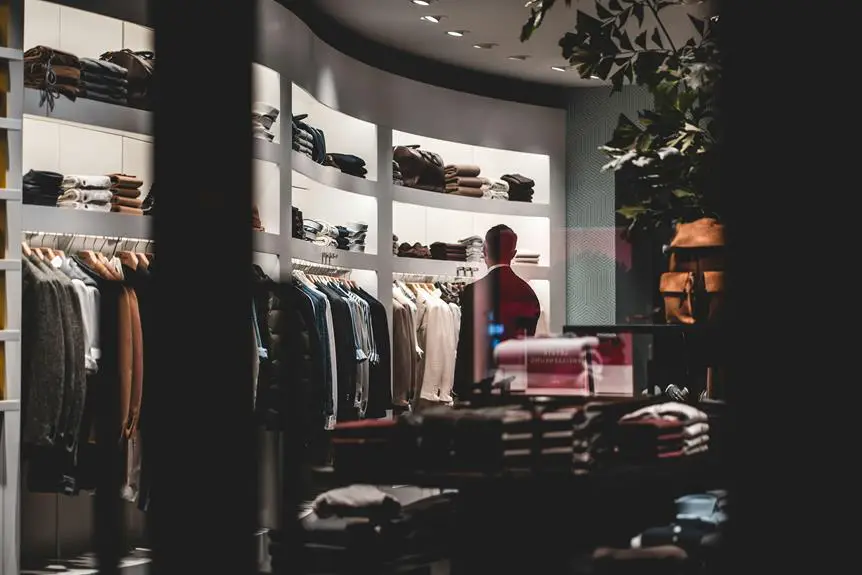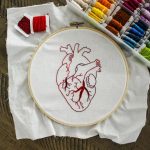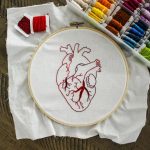When you think about custom apparel, riveting might not be the first thing that comes to mind, yet it plays a pivotal role in both functionality and style. It not only reinforces key stress points in garments but also opens the door to endless creative possibilities through various designs. As you explore the different types of rivets and their applications, you might find yourself questioning how this technique can transform your own wardrobe. What innovative uses of riveting are emerging in the fashion world today?
Table of Contents
Key Takeaways
- Riveting enhances durability in custom apparel, reinforcing stress points to prevent ripping and extending the life of garments.
- Aesthetic appeal is boosted by rivets, allowing for unique designs and personalization through various shapes, sizes, and finishes.
- Functional rivets improve weather resistance, creating a tighter seal against elements and adding practical benefits alongside style.
- Customization with rivets can create striking visual patterns, guiding the viewer's eye and breaking the monotony of flat fabrics.
Historical Significance of Riveting
Riveting has played a crucial role in the evolution of custom apparel, transforming how garments are constructed and customized throughout history. You mightn't realize it, but rivets have been integral to fashion since ancient times, providing strength and durability to clothing. They've allowed for innovative designs, enabling artisans to fuse materials in ways that stitching alone couldn't achieve.
As you explore the history of riveting, you'll find that it emerged prominently during the Industrial Revolution, when mass production began to reshape the apparel industry. Manufacturers started adopting rivets to reinforce seams, particularly in workwear, ensuring garments could withstand rugged use. This practice didn't just enhance functionality; it also paved the way for creative expression in fashion.
You can trace the evolution of riveting through various styles, from the punk rock aesthetic of the 1970s to modern high-fashion looks. Each era has utilized rivets to convey a message or identity, showcasing their versatility.
Types of Rivets in Fashion
When it comes to rivets in fashion, you'll find both functional and decorative styles that serve distinct purposes.
Functional rivets enhance durability, while decorative ones add flair to your apparel.
Let's explore the various types you can incorporate into your designs.
Functional Rivets Overview
Exploring the various types of rivets in fashion reveals how these small yet significant details can enhance both functionality and style in custom apparel.
Functional rivets serve practical purposes, providing strength, durability, and reinforcement in your garments.
One popular type is the solid rivet, which consists of a cylindrical shaft and a head, creating a strong bond. You'll often find these used in denim and leather, where additional durability is essential.
Next, there are tubular rivets, which feature a hollow core. These are lighter and often used in lighter fabrics while still maintaining structural integrity.
Then there are blind rivets, which are perfect for situations where only one side of the fabric is accessible. They're ideal for creating a polished, clean look without visible fasteners on the outside.
Lastly, you have snap rivets, which combine the functionality of a snap with the durability of a rivet. They're often seen in jackets and bags, allowing for easy access while ensuring a secure closure.
Choosing the right type of rivet can significantly impact your garment's overall functionality and longevity, making them essential in custom apparel design.
Decorative Rivets Styles
Decorative rivets add a unique flair to custom apparel, transforming ordinary pieces into eye-catching fashion statements. These little embellishments not only enhance the style of your clothing but also express your individuality.
When considering rivet styles, here are four popular options to think about:
- Flat Rivets: These rivets lie flush against the fabric, offering a subtle yet stylish touch. They're great for a minimalist look.
- Domed Rivets: With a rounded shape, domed rivets create a more pronounced effect. They're perfect for adding a playful element to jackets and bags.
- Star Rivets: If you want to make a bold statement, star-shaped rivets can add an edgy vibe. They work well on denim and leather pieces.
- Colored Rivets: Available in a variety of hues, colored rivets can match or contrast with your fabric, allowing you to personalize your designs effortlessly.
Choosing the right decorative rivets can elevate your custom apparel, making it not just functional but also a true reflection of your style.
Functional Benefits of Riveting
Riveting not only enhances the durability and longevity of your custom apparel but also improves its structural integrity.
You'll appreciate how these functional benefits contribute to a garment's overall quality and wearability.
Plus, with the aesthetic appeal and customization options, riveting allows you to express your unique style while ensuring your pieces stand the test of time.
Enhanced Durability and Longevity
Using riveting in custom apparel significantly boosts durability, ensuring your garments withstand wear and tear over time. This method not only enhances the lifespan of your clothing but also provides functional benefits that you'll appreciate.
Here are four key reasons why riveting can make a difference:
- Reinforced Stress Points: Rivets strengthen areas that typically endure the most strain, like pockets and seams, so you won't have to worry about them ripping or tearing.
- Weather Resistance: Riveting can help create a tighter seal in your garments, making them more resistant to elements like wind and rain, keeping you comfortable.
- Less Frequent Repairs: With the added durability, you'll find that your clothes require fewer repairs, saving you time and money in the long run.
- Stylish Functionality: Rivets not only serve a practical purpose but also add an edgy aesthetic to your apparel, allowing you to express your unique style while enjoying the benefits of durability.
Improved Structural Integrity
Rivet-enhanced apparel boasts improved structural integrity, ensuring that your garments maintain their shape and functionality even under demanding conditions. When you choose clothing with riveting, you're investing in pieces that resist stress and strain better than traditional stitching. The rivets distribute weight and pressure evenly across the fabric, preventing weak points that often lead to tears or deformation.
This added strength means your apparel can handle the rigors of daily wear, from outdoor adventures to rigorous workouts. You won't have to worry about seams splitting or fabric sagging, allowing you to focus on your activities without the distraction of potential wardrobe malfunctions.
Moreover, rivets provide a reliable bond between different materials, making them ideal for multi-layered designs. Whether you're sporting a rugged jacket or a functional pair of pants, the rivets reinforce those critical junctions, ensuring your clothing remains intact and performs optimally over time.
In a world where durability is key, riveted apparel stands out by offering peace of mind, knowing your garments are built to last. You're not just wearing a piece of clothing; you're donning a resilient part of your wardrobe that supports your lifestyle.
Aesthetic Appeal and Customization
In addition to their durability, rivets add a striking visual element to your apparel, allowing for unique customization that reflects your personal style. You can transform a basic piece into something truly special, making a statement with every outfit.
Here are a few ways rivets enhance your apparel's aesthetic appeal:
- Variety of Shapes and Sizes: Rivets come in numerous designs, from classic round to edgy star shapes. You can choose what fits your vibe best.
- Color Options: Whether you prefer metallic, matte, or colored finishes, the right rivet can complement or contrast your fabric, adding depth to your look.
- Placement Flexibility: You can position rivets strategically to draw attention to certain areas, like seams or pockets, creating visual interest where you want it.
- Personalized Designs: Customizing your apparel with rivets allows you to express your personality. You can create patterns or motifs that are uniquely yours.
Aesthetic Enhancements Through Riveting
Rivets add a bold, eye-catching detail to custom apparel, transforming ordinary pieces into striking fashion statements. When you incorporate rivets into your designs, you instantly elevate the visual appeal. These metal accents catch the light and draw attention, making your garments stand out in any setting.
Imagine wearing a jacket adorned with rivets along the shoulders or down the sleeves. It's not just a jacket anymore; it becomes a statement piece that reflects your unique style. You can use rivets to create patterns or highlight specific areas of the clothing, guiding the viewer's eye and enhancing the overall design.
Moreover, rivets offer versatility. You can choose from various sizes, shapes, and finishes to match your aesthetic. Whether you're going for a punk rock look or something more refined, rivets can complement your vision.
In addition to aesthetics, rivets can also add texture, breaking up the monotony of a flat fabric surface. This tactile element invites touch and curiosity, further engaging those who see your custom apparel.
Riveting Techniques and Methods
To bring your riveting designs to life, you'll want to explore various techniques and methods that ensure both durability and style in your custom apparel. Here are some effective riveting techniques to consider:
- Cold Riveting: This method involves using a hammer or a rivet gun to set rivets without heat, making it ideal for delicate fabrics where you don't want to compromise integrity.
- Hot Riveting: If you're working with thicker materials, hot riveting can create a strong bond. This technique requires heating the rivet before insertion, ensuring a secure fit.
- Self-Piercing Rivets: These are great for materials that can't be pre-drilled. They pierce through the layers as they're set, making them a time-saving option for your projects.
- Blind Rivets: Perfect for situations where you can't access the backside of the material, blind rivets allow you to secure two pieces together without needing to reach around.
Future Trends in Riveting
Emerging technologies and innovative materials are set to transform the riveting landscape in custom apparel, enhancing both functionality and aesthetic appeal.
You'll likely see a rise in the use of lightweight, durable materials that provide better strength-to-weight ratios, making garments more comfortable without sacrificing quality. Smart textiles are also on the horizon, integrating electronic components that can communicate or change appearance through riveting.
As brands explore personalization, you might find customizable riveting options becoming a staple. Imagine choosing your rivet style, color, and placement to create a unique look that reflects your individuality.
Sustainability will play a key role too; you can expect more eco-friendly rivets made from recycled or biodegradable materials, aligning your fashion choices with environmental responsibility.
Automation and 3D printing are making waves as well. These technologies can streamline the riveting process, allowing for intricate designs and rapid prototyping.
With these advancements, you'll enjoy quicker turnaround times for custom pieces. As you navigate this evolving landscape, keep an eye out for these trends that will redefine how you experience riveting in apparel.
Frequently Asked Questions
Can Riveting Be Used on All Types of Fabrics?
Riveting can be used on many fabrics, but it's not suitable for all. You should consider the fabric's weight and texture. Lighter materials might not hold rivets well, while sturdier fabrics are more compatible.
How Do I Care for Riveted Apparel?
To care for riveted apparel, wash it gently in cold water and avoid harsh detergents. Don't use bleach, and air dry it to preserve the integrity of the rivets and fabric. Store it flat or hanging.
Are There Any Safety Concerns With Rivets?
Yes, there can be safety concerns with rivets. They might snag on clothing or cause injury if they're sharp or improperly secured. Always check for wear and ensure rivets are smooth to prevent accidents.
Can Rivets Be Removed Without Damaging the Garment?
Yes, you can remove rivets without damaging the garment, but it requires careful handling. Use a specialized tool to gently pry them off. Always check the fabric type to avoid unintentional tears or fraying during the process.
What Tools Are Needed for DIY Riveting?
For DIY riveting, you'll need a rivet setter, a hammer, a drill, and appropriate rivets. Make sure to have a cutting mat or surface to protect your work area while you create your project.
- What Is Acetate Satin? A Guide to This Luxurious Fabric - June 24, 2025
- Does Acetate Fabric Wrinkle Easily? Tips for a Crease-Free Look - June 24, 2025
- Exploring Acetate Blends: Cotton, Polyester, and Rayon Mixes Explained - June 24, 2025







